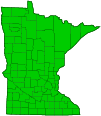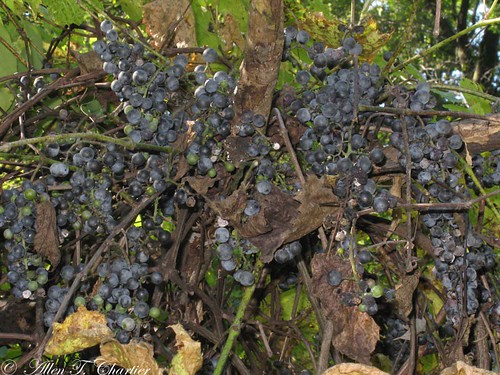wild grape
(Vitis riparia)
Conservation • Wetland • Description • Habitat • Ecology • Use • Distribution • Taxonomy
Description |
||
Wild grape is a high-climbing, 6″ to 24″ tall when sprawling, perennial, woody vine rising from a taproot. The vine of the current season is green to gray or brown, lightly ridged, and hairless or lightly hairy. When they mature they become covered with reddish-brown bark. On old growth the bark sheds in long, thin strips. It extends up to 50′. Tendrils form opposite most leaves but are lacking every third leaf. The leaves are alternate, yellowish-green, 4″ to 8″ wide, round to egg-shaped, and lobed with a heart-shaped base. They are on long leaf stalks. The lobing pattern is highly variable, even on the same plant, but they are usually divided into 3 forward-pointing lobes. Leaf margins are sharply toothed. Young leaves are hairless on the upper side, hairy on the underside. As they mature the undersides become green and hairless except for tufts of short, soft hairs in the vein axils and sometimes along the veins. Male and female flowers are found in separate inflorescences on the same plant. The inflorescences are borne opposite most leaves but are lacking every third leaf. They are 2″ to 4″ long. Flowers are inconspicuous, tiny, greenish white or greenish-yellow and fragrant. They have 5 petals. The fruit is a black, purple, or blue, ¼″ to ½″ thick juicy berry with 2 to 6 seeds. The berry has a whitish, waxy bloom at maturity. |
||
Height |
||
6″ to 24″ when sprawling, climbing to 66′ |
||
Flower Color |
||
Greenish-white or greenish-yellow |
||
Similar Species |
||
Silverleaf grape (Vitis aestivalis var. bicolor) leaves are whitish on the underside. Canada moonseed (Menispermum canadense) leaves are bluish-green and untoothed. There are no tendrils. The fruits are poisonous and contain a single, crescent-shaped seed. |
||
Habitat |
||
Moist. Floodplain forests, wooded swamps, upland woods, riverbanks, thickets, and roadsides. Full sun. |
||
Ecology |
||
Flowering |
||
Mid-June to early July |
||
Pests and Diseases |
||
Grape gall midge (Schizomyia vitiscoryloides) Grape leaf miner moth (Phyllocnistis vitegenella) creates conspicuous lines beneath the outer layer of cells (mines) that snake across the leaf surface. The mines are silvery-white with a central, broad, dark, frass line. They are unsightly but do not significantly affect the health of the plant. Grape leaf miner moth (Phyllocnistis vitifoliella) creates conspicuous lines beneath the outer layer of cells (mines) that snake across the leaf surface. The mines are uniformly whitish with no visible frass line. They are unsightly but do not significantly affect the health of the plant. Grape phylloxera (Daktulosphaira vitifoliae) |
||
Use |
||
|
||
Distribution |
||||
|
Sources |
|||
| 6/14/2023 | ||||
Nativity |
||||
Native |
||||
Occurrence |
||||
Common and widespread |
||||
Taxonomy |
|||
| Kingdom | Plantae (Plants) | ||
| Division | Tracheophyta (Vascular Plants) | ||
| Subdivision | Spermatophytina (Seed Plants) | ||
| Class | Magnoliopsida (Dicots) | ||
Order |
Vitales grapes and allies) | ||
Family |
Vitaceae (grape) | ||
| Subfamily | Vitoideae | ||
Genus |
Vitis (grapevines) | ||
Subordinate Taxa |
|||
|
|||
Synonyms |
|||
Vitis riparia var. praecox Vitis riparia var. syrticola Vitis vulpina var. praecox Vitis vulpina ssp. riparia Vitis vulpina var. syrticola |
|||
Common Names |
|||
frost grape riverbank grape river-bank grape wild grape |
|||
Glossary
Axil
The upper angle where the leaf stalk meets the stem.
Visitor Photos |
|||||
Share your photo of this plant. |
|||||
| This button not working for you? Simply email us at info@MinnesotaSeasons.com. Attach one or more photos and, if you like, a caption. |
|||||
Michelle Groetsch |
|||||
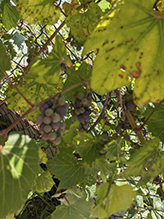 |
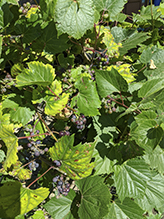 |
||||
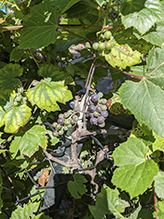 |
|||||
MinnesotaSeasons.com Photos |
|||||
Plant |
|||||
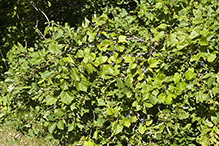 |
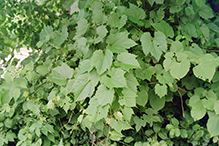 |
||||
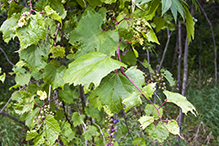 |
|||||
Leaves |
|||||
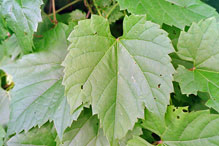 |
|||||
Infructescence |
|||||
 |
 |
||||
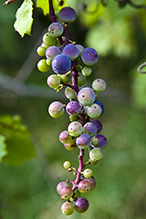 |
|||||
Fruit |
|||||
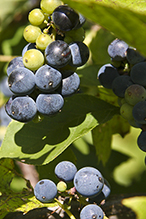 |
|||||

Visitor Videos |
|||
Share your video of this plant. |
|||
| This button not working for you? Simply email us at info@MinnesotaSeasons.com. Attach a video, a YouTube link, or a cloud storage link. |
|||
Other Videos |
|||
| Riverbank Grape TheNatureTeacher |
|||
About
Published on Sep 11, 2012 |
|||
| Dave's Vines David Redic |
|||
About
Uploaded on Sep 13, 2008 Dave Redic shows us the two wild grapevines of northeast Ohio, Vitis Riparia, Riverbank Grape Vine, and Vitis Argentifolia, Silver Leaf Grape Vine. |
|||
| Foraging Wild Grapes RevolutionOfThought1 |
|||
About
Published on Aug 14, 2013 There are many species of Native American grapes, this particular species "Vitis Riparia" also know as the frost grape has been used for over a hundred years in to create hardy domestic grapes. Small, tart, plentiful,& pungent its used to make things from wine to jams. In this video I talk about this vigorous native grape vine, & share the awesome experience of foraging them. Song: Pigeons Under Water DISCLAIMER: I DO NOT OWN THE AUDIO, NO COPYRIGHT INFRINGEMENT INTENDED. |
|||
| Riverbank Grape in Northern Wine Making TheCampusTrees |
|||
About
Published on Apr 16, 2014 Riverbank grape (Vitis riparia) is a grape native to North America and grows wild across much of the Northern part of the continent. While its unpleasant taste, diminutive size, and seedy texture make it more fitting for wild animal browsing than human consumption, Vitis riparia has a secret weapon - it's cold hardiness. By mixing the freeze resistant genes of riverbank with premium table grapes wine stocks for the Northern latitudes are now available. |
|||

Visitor Sightings |
|||||
Report a sighting of this plant. |
|||||
| This button not working for you? Simply email us at info@MinnesotaSeasons.com. Be sure to include a location. |
|||||
| Michelle Groetsch 7/31/2020 |
Location: Sauk Centre, Stearns County |
 |
|||
MinnesotaSeasons.com Sightings |
|||||
Avon Hills Forest SNA, North Unit Bertram Chain of Lakes Regional Park Carpenter St. Croix Valley Nature Center Carver Highlands WMA, South Unit Charles A. Lindbergh State Park Clifton E. French Regional Park Clinton Falls Dwarf Trout Lily SNA Felton Prairie SNA, Bicentennial Unit Forestville/Mystery Cave State Park Hardscrabble Woods / MG Tusler Sanctuary John Peter Hoffman Spring Brook Valley WMA Kellogg Weaver Dunes SNA, Weaver Dunes Unit Margherita Preserve-Audubon Prairie Mary Schmidt Crawford Woods SNA Minnesota Valley NWR, Chaska Unit Minnesota Valley NWR, Louisville Swamp Unit Minnesota Valley NWR, Rapids Lake Unit Minnesota Valley NWR, Wilkie Unit Minnesota Valley State Recreation Area, Lawrence Unit Mound Spring Prairie SNA, North Unit Nerstrand Big Woods State Park Northern Tallgrass Prairie NWR, Hoffman Unit Northern Tallgrass Prairie NWR, Rengstorf Unit P.N. and G.M. Nelson Wildlife Sanctuary Prairie Creek WMA, Koester Prairie Unit Robert Ney Memorial Park Reserve Sand Prairie Wildlife Management and Environmental Education Area |
|||||

|
Created: Last Updated: © MinnesotaSeasons.com. All rights reserved. |
